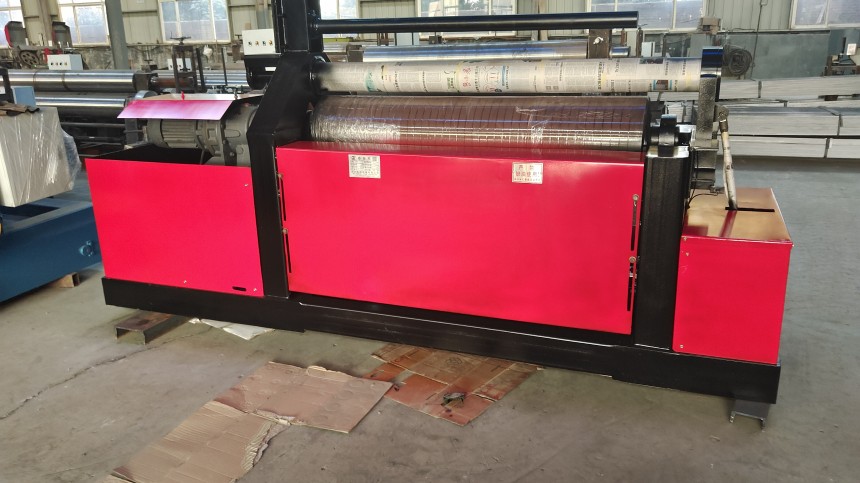

We are a professional manufacturer of plate rolling machines with over 10 years of industry experience. Today, we would like to introduce the technical characteristics of plate rolling machine to you:
In modern industrial manufacturing, plate rolling machine, as the core equipment for metal plate forming and processing, is widely used in the fields of ship, pressure vessel, automobile manufacturing and so on. Its technical characteristics not only determine the processing efficiency and precision, but also directly affect the final quality of the product. In this paper, we will analyze the core technical characteristics of plate rolling machine from the dimensions of structural design, control technology and functional innovation.
1, Structural design: The cornerstone of stability and efficiency
The core structure of the plate rolling machine consists of the frame, rollers and transmission system, the design of which directly determines the carrying capacity and processing range of the equipment.
Rigid frame design: The use of integral casting or high-strength steel plate welded frame structure to ensure that the equipment remains stable under high pressure and high load, reducing the risk of deformation. For example, some high-end models improve fatigue resistance by optimizing the frame geometry and dispersing stress concentration points.
Roller material and technology: The work roller is usually made of alloy steel, the surface is hardened by high-frequency quenching or hard chrome plating treatment, which not only enhances the wear resistance, but also reduces the friction coefficient with the plate, avoiding scratches on the workpiece.
Multi-roll synergistic structure: Three-roll, four-roll or more rollers combined design, can adapt to different thicknesses of the plate bending needs. The four-roller plate rolling machine reduces the straight edge residue at the head and tail of the plate by adding auxiliary rollers to improve the material utilization rate.
This structural design ensures the strength of the equipment while balancing flexibility and processing accuracy.
2, Intelligent control technology: The integration of precision and convenience
With the development of industrial automation, the control system of the plate rolling machine is upgraded from mechanical operation to digitalization and intelligence, which has become the core direction of its technological iteration.
Integration of CNC system: Modern plate rolling machines are commonly equipped with CNC system, which automatically adjusts roller pressure, speed and feed through preset programs. The operator only needs to input the plate parameters (thickness, material, target curvature), the system can automatically generate the processing path, significantly reducing manual intervention.
Dynamic compensation function: For plate rebound, temperature changes and other disturbing factors, some models are equipped with real-time monitoring sensors, combined with algorithms to dynamically correct the position of the roll axis, to ensure that the molding accuracy is stable within ± 0.1 mm.
Optimization of human-computer interaction: The touch screen interface integrates graphical operation guidelines and supports simulated processing preview, which intuitively demonstrates the bending process of the plate and reduces the threshold of operation. Part of the equipment can also be used to remotely monitor the operating status through the Internet of Things module to realize preventive maintenance.
Intelligent control technology not only improves the processing efficiency, but also transforms the traditional experience-dependent “handicraft work” into quantifiable and reproducible standardized processes.
3, Functional innovation: From single to multiple breakthroughs
In order to meet the processing needs of complex workpieces, the functional design of the plate rolling machine is constantly extended to multi-functional, highly adaptable.
Integration of pre-bending and leveling: Some high-end models will be pre-bending function integrated into the main processing process, by adjusting the roller spacing and pressure, directly eliminate the straight edge defects at the end of the plate, reducing the subsequent secondary processing links.
Functional innovations have transformed the plate rolling machine from a single processing tool to a comprehensive molding platform, adapting to more industrial scenarios.
4, Safety and energy saving: The wings of sustainable development
Under the trend of greening industrial equipment, the safety and energy consumption design of the plate rolling machine has become an important technical index.
Multiple safety protection: Equipped with photoelectric sensing emergency stop device, overload protection system, and physical isolation guardrail to avoid operators from accidentally touching the dangerous area. Some models are designed with a two-button startup to ensure that the operator's hands are kept away from the rollers.
Energy recovery technology: Accumulators are added to the hydraulic system to recover energy during unloading or no-load operation, reducing overall power consumption. Measured data shows that this type of design can reduce power consumption by 15%-20%.
Low noise design: By optimizing the gear meshing precision and adding shock absorbing cushions, the noise of the equipment operation is controlled to be below 75dB, which improves the working environment of the workshop.
These technical improvements not only ensure production safety, but also meet the strict requirements of modern industry on environmental protection and energy efficiency.
The technological development of the plate rolling machine is essentially a continuous response to the three core demands of “precision, efficiency and safety” in the field of machinery manufacturing. From the physical support of the rigid structure to the precise regulation of the intelligent system, from a single function to multiple expansion, its technical characteristics have always been centered on the actual production pain points to carry out innovation. In the future, with the further integration of materials science and artificial intelligence, the plate rolling machine may achieve greater breakthroughs in the field of adaptive learning, fully automated production line integration, and continue to promote the transformation and upgrading of the metal processing industry.
If you are interested in plate rolling machine, please contact us.

 Address:Room 1202, Detaitang Building, No. 118 Huaguang Road, Zhangdian District, Zibo, Shandong
Address:Room 1202, Detaitang Building, No. 118 Huaguang Road, Zhangdian District, Zibo, Shandong WhatsApp:+8615653328535
WhatsApp:+8615653328535 Wechat: +8615965331535
Wechat: +8615965331535  E-mail:zs@sdsmachinery.com
E-mail:zs@sdsmachinery.com